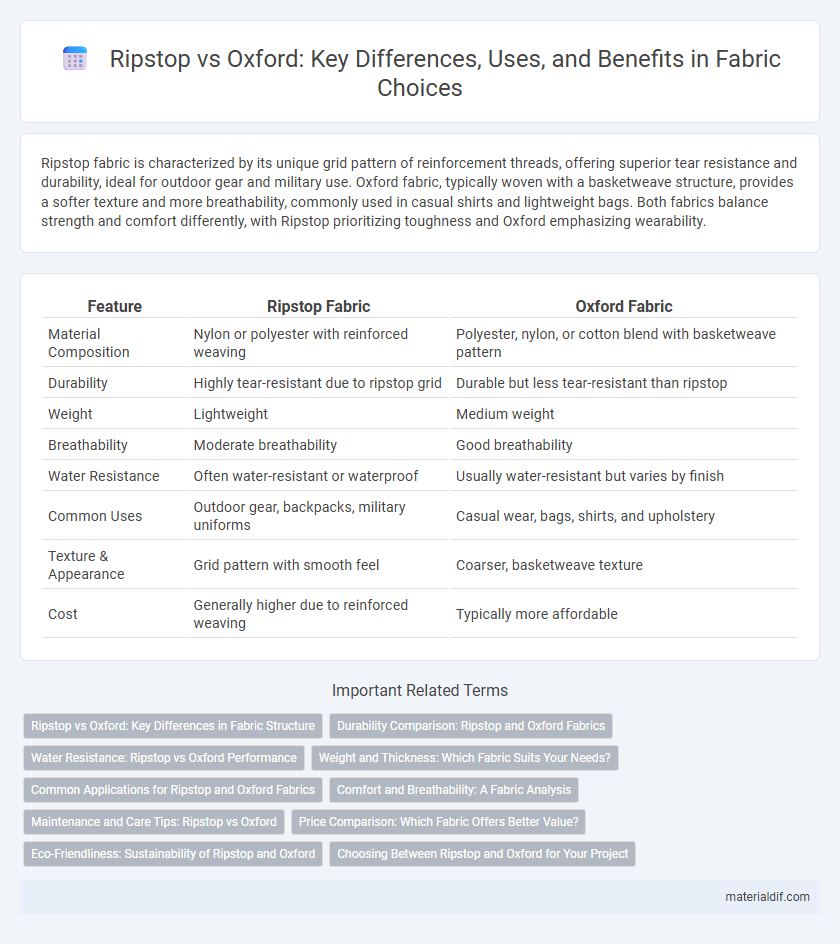Ripstop fabric is characterized by its unique grid pattern of reinforcement threads, offering superior tear resistance and durability, ideal for outdoor gear and military use. Oxford fabric, typically woven with a basketweave structure, provides a softer texture and more breathability, commonly used in casual shirts and lightweight bags. Both fabrics balance strength and comfort differently, with Ripstop prioritizing toughness and Oxford emphasizing wearability.
Table of Comparison
| Feature | Ripstop Fabric | Oxford Fabric |
|---|---|---|
| Material Composition | Nylon or polyester with reinforced weaving | Polyester, nylon, or cotton blend with basketweave pattern |
| Durability | Highly tear-resistant due to ripstop grid | Durable but less tear-resistant than ripstop |
| Weight | Lightweight | Medium weight |
| Breathability | Moderate breathability | Good breathability |
| Water Resistance | Often water-resistant or waterproof | Usually water-resistant but varies by finish |
| Common Uses | Outdoor gear, backpacks, military uniforms | Casual wear, bags, shirts, and upholstery |
| Texture & Appearance | Grid pattern with smooth feel | Coarser, basketweave texture |
| Cost | Generally higher due to reinforced weaving | Typically more affordable |
Ripstop vs Oxford: Key Differences in Fabric Structure
Ripstop fabric features a distinctive grid pattern of reinforced threads woven into the material, providing enhanced tear resistance and durability compared to Oxford fabric. Oxford fabric utilizes a basket weave construction, which gives it a smoother texture and a slightly heavier feel but less resistance to tearing. The structural difference makes Ripstop ideal for applications requiring lightweight strength, while Oxford is preferred for aesthetic versatility and comfort.
Durability Comparison: Ripstop and Oxford Fabrics
Ripstop fabric features a grid pattern reinforced with thicker threads that prevent tearing and enhance resistance to ripping, making it ideal for high-stress applications. Oxford fabric combines a basket-weave structure with durable yarns, providing substantial abrasion resistance and robustness suited for everyday use in bags and outdoor gear. When comparing durability, Ripstop excels in tear prevention while Oxford offers superior resistance to wear and long-term durability under frequent friction.
Water Resistance: Ripstop vs Oxford Performance
Ripstop fabric features a grid pattern of reinforced threads that enhances water resistance by preventing tears from spreading, making it highly durable in wet conditions. Oxford fabric, typically woven with a basketweave structure, offers moderate water resistance but tends to absorb moisture more readily compared to Ripstop. For applications requiring superior water repellency and tear resistance, Ripstop fabric is the preferred choice over Oxford.
Weight and Thickness: Which Fabric Suits Your Needs?
Ripstop fabric is lightweight yet highly durable, typically weighing between 100 to 250 grams per square meter, making it ideal for applications requiring strength without added bulk. Oxford fabric, known for its thicker weave and weight ranging from 200 to 400 grams per square meter, offers a sturdier and more substantial feel suited for heavy-duty use. Choosing between Ripstop and Oxford depends on whether you prioritize lightweight performance or enhanced thickness and durability for your specific project.
Common Applications for Ripstop and Oxford Fabrics
Ripstop fabric is commonly used in outdoor gear such as tents, backpacks, and military uniforms due to its lightweight durability and tear-resistant grid pattern. Oxford fabric, known for its heavier weight and smooth texture, is frequently applied in making durable shirts, bags, and upholstery. Both fabrics are chosen based on the need for strength and abrasion resistance in everyday and technical applications.
Comfort and Breathability: A Fabric Analysis
Ripstop fabric offers superior breathability and lightweight comfort due to its tightly woven nylon or polyester fibers with reinforcing crosshatch patterns, making it ideal for outdoor and active wear. Oxford fabric, typically made from cotton or polyester blends, provides a soft, smooth texture with moderate breathability but tends to be heavier and less airy compared to ripstop. The choice between ripstop and Oxford depends on prioritizing durability and ventilation versus a softer feel and moderate comfort.
Maintenance and Care Tips: Ripstop vs Oxford
Ripstop fabric requires minimal maintenance due to its tightly woven structure that resists tearing and stains, often needing only gentle washing and air drying to maintain durability. Oxford fabric, characterized by its basketweave texture, benefits from regular cleaning to prevent dirt buildup between fibers and typically requires low heat ironing to preserve its smooth appearance. Both fabrics perform well with mild detergents and should be dried away from direct sunlight to avoid color fading and material degradation.
Price Comparison: Which Fabric Offers Better Value?
Ripstop fabric typically costs more than Oxford due to its reinforced weave that resists tearing and enhances durability, making it ideal for outdoor gear and high-stress applications. Oxford fabric offers a more budget-friendly option with moderate strength and a smooth texture, commonly used for casual apparel and light-duty bags. Considering long-term use and cost per durability, Ripstop may provide better value despite a higher upfront price, while Oxford suits those seeking affordable fabric for less demanding purposes.
Eco-Friendliness: Sustainability of Ripstop and Oxford
Ripstop fabric is typically made from recycled nylon or polyester, making it a more sustainable choice due to its durability and resistance to tearing, which extends product lifespan. Oxford fabric, often woven from cotton or synthetic blends, varies in eco-friendliness depending on the fiber source and production methods, with organic cotton Oxford offering improved sustainability. Both fabrics offer eco-friendly options, but Ripstop's long-lasting strength and recycled material content generally provide a lower environmental impact.
Choosing Between Ripstop and Oxford for Your Project
Ripstop fabric is ideal for projects requiring lightweight durability and tear resistance, commonly used in outdoor gear and military applications, while Oxford fabric offers a heavier, water-resistant option favored in bags and upholstery. Consider the specific demands of your project: Ripstop excels in preventing fabric tears due to its reinforced grid pattern, whereas Oxford provides a thicker, more abrasion-resistant surface suitable for heavy use. Selecting between Ripstop and Oxford depends on balancing the need for weight, durability, and texture to match the intended application and environmental conditions.
Ripstop vs Oxford Infographic

 materialdif.com
materialdif.com